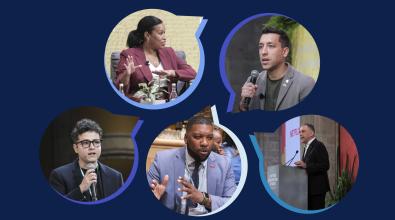New research finds ‘formality effect’ in local government letters

As part of Bloomberg Philanthropies' support for the Bloomberg Center for Cities at Harvard University, the renowned behavioral scientist Elizabeth Linos and The People Lab came to Harvard last year. Here, we talk about some of her field-leading research and how it applies to the work of city leaders today.
Many people these days dress, talk, and act more casually than their grandparents did. But local leaders may want to keep it formal—at least in how they approach certain written communications with residents.
That’s one surprising, if preliminary, finding in a recent working paper by a group of behavioral scientists researching what works in government communications.
The paper, which has not yet been peer reviewed and is meant to spark discussion, finds evidence of what the authors call the “formality effect.”
The finding suggests that city halls consider ditching eye-catching graphics or a chatty tone in written communications with residents—at least when the goal is to get them to sign up for a service, pay a bill, or otherwise take action on something.
Instead, they should consider using standard typefaces, minimal formatting, and impersonal language—signals of formality that people associate with government. In a world where spammers and scammers are up to no good, the paper says, “Recipients view the source of a formal letter as more competent and trustworthy, and view the request itself as more important to take action on.”
The ongoing research builds on years of work supported by Bloomberg Philanthropies aimed at helping local governments use behavioral science to build evidence-based strategies and programs. With help from What Works Cities and partners at the Behavioral Insights Team, a number of those cities, including two cited in the study, have run randomized-control trials testing letters or postcards sent to residents for various reasons. Results showed what few local leaders involved in those trials expected: that more formal approaches can produce better results than informal ones.
That finding still comes as a surprise to many experts, who have assumed that government needs to “loosen up” to break through in communication with residents. The study reports that 351 practitioners and researchers overwhelmingly—and wrongly—predicted that informal communications would be more effective at encouraging residents to act.
To learn more about the formality effect and how local leaders can leverage it in their work, Bloomberg Cities spoke with Elizabeth Linos, the lead author of the working paper. Linos is the Emma Bloomberg Associate Professor for Public Policy and Management, and Faculty Director of The People Lab at the Harvard Kennedy School of Government.
What questions were you and your co-authors looking at in this study and what did you find?
My team at The People Lab and others who are at the intersection of public management and behavioral science are always thinking about how we can use tools from behavioral science to make sure that government communications are meeting their target goals. Whether it’s getting a resident to take up a program they're eligible for or getting them to pay their taxes, the fundamental question is the same: Government has this tool, which is often written communication, and needs residents to do something. And the question is how to motivate them?
[Read: What's next for behavioral 'nudges'?]
Years ago when I was at The Behavioral Insights Team, we had done some trials where formal communication ended up doing better—and there was an open question as to why. And so with this project we asked: Is this a real thing? Is formality better for some kinds of communication? How do people respond to more formal or informal communication? And importantly, what do people expect of government? Because a lot of this is about expectations.
Now that we have studied this systematically, we see a consistent finding where more formal communication ends up doing better in terms of engaging residents. And then the question is: Why? We think the answer is related to two things. One is making sure that the source of that communication is credible. And the second is making sure it's clear that the message is important. And we think formality ends up being a mental shortcut for both.
How do you define formality?
We are defining formality in written communications along two axes.
One is aesthetics. Formal aesthetics are things like not using any images or color. And using traditional fonts, like Times New Roman. Black-and-white communication.
The other axis is language. More formal tones might include using the passive voice, less personalization, and a higher reading level. Although—and this is critical—formality is not the same as complexity. You can be more formal and use simple language that is not technocratic.
We find that when you show people different versions of letters where you vary those two axes, people very consistently recognize one as more formal than the other.
And how do you see the preference for formality play out in field experiments?
There are three different policy contexts in the field experiments. One is a process where the local government “ask” is getting businesses to register as a minority- or woman-owned business. The second is around encouraging residents to enroll in one city’s emergency medical service provided by the government. And then the third is from a state-level project where we were trying to encourage people to take up the Earned Income Tax Credit.
Across these very different contexts, we see that the more formal communication does better.
[Read: Meet the 'nudgers' who are pushing behavioral science to new levels]
What's interesting is that we showed those exact same communications to both city-level practitioners and behavioral science scholars. And basically everybody predicts this incorrectly. Somewhere between 80 and 90 percent of people predict that the more informal communication will do better. So part of the purpose of this paper is to say, actually, we need to be more thoughtful about our intuition on these issues.
That’s fascinating. What do you think explains the incorrect assumption that informality works?
One is that, for a very long time, we've made a mental leap between grabbing people's attention and getting them to do things. We all leaned on this literature that says if you use colors and bright fonts and make things more salient, you can grab people's attention, But we hadn’t tested that second assumption, that getting attention was enough to produce behavior change.
All of this is in a world where other players are using these tools as well. For government, differentiating yourself is not just about a visual attention grab. It's also about trying to make sure that your communication is considered credible in a world where people are getting a ton of communication from non-credible sources as well.
What should local government practitioners do with these findings?
These results were very surprising, even to those of us who have been doing this work for a decade now. And I know it was surprising to a lot of practitioners as well. So the first lesson is making sure we're continuing to question our assumptions about what works for residents—and testing in a data-driven way how to best communicate with residents.
[Read: 7 behavioral insights tips from pioneering cities in the field]
Our findings suggest that government doesn't have to compete with private-sector players on being the most informal or the most personable or the most cute and funny. In fact, that could have negative effects in terms of people believing that the message comes from government and that they should take the message seriously.
What this doesn't say is that government communication should be full of jargon or complex or difficult to read. We have examples in the paper of formal communications that are still very simple and clear in terms of comprehension.
One thing to note is that this is a new and surprising finding, and we have to do a lot more research to figure out exactly what it means for different types of communications or resident-state interactions. We don't know yet if this would apply to in-person communication or text messages. We also don't know if it applies in other cultural contexts outside the U.S. So there’s still a lot to learn.


